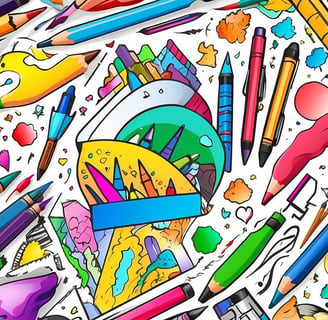How Do I Choose Between Crayons, Pencils, and Markers?
A Detailed Guide for Beginners
12/28/20233 min read


Embarking on a coloring journey brings up an important question: should you use crayons, pencils, or markers? This blog post delves into the characteristics, advantages, and considerations of each, guiding beginners in making an informed choice.
1. Understanding Crayons, Pencils, and Markers
Before diving into the specifics, it's essential to understand what each tool offers.
Crayons (Amazon): Wax-based, vibrant, and easy to use. Ideal for broad, textured strokes.
Pencils (Amazon): Offer precision and versatility. Perfect for detailed work.
Markers (Amazon): Known for their bold, fluid color. Great for covering large areas.
2. Crayons: The Colorful Beginning
Crayons for Beginners (Amazon)
Advantages: Non-toxic, easy to grip, and no need for sharpening. They're perfect for beginners who are learning color basics.
Best Use: Ideal for large, less detailed areas and for developing basic motor skills.
Brand Recommendations: Crayola (Amazon), Faber-Castell (Amazon), and Lyra (Amazon) are excellent choices for their quality and range of colors.
3. Colored Pencils: Precision and Subtlety
Why Choose Colored Pencils on Amazon?
Benefits: Offer more control and are excellent for layering and blending.
Skill Development: They help in improving fine motor skills and are great for detailed artwork.
Top Picks for Beginners: Prismacolor Premier (Amazon), Derwent Academy (Amazon), Soucolor (Amazon) and Faber-Castell Polychromos (Amazon) are highly recommended for their quality.
4. Markers: Bold and Expressive
Unique Qualities: Provide smooth, vibrant, and consistent color. Ideal for bold statements and large areas, for example, check out these Mogyann Markers on Amazon which are specially made for adult coloring (Amazon).
Variety: Available in water-based, alcohol-based, and even solvent-based varieties - explore them all at Amazon.
Recommended Brands: For beginners, Crayola Supertips (Amazon), Mogyann Markers (Amazon), Swemos Markers, and black Sharpie markers (Amazon) as well as Sharpie markers in color (Amazon) offer a great balance between quality and ease of use.
5. Factors to Consider When Choosing
Personal Preference: Your personal style and preference play a significant role. Do you prefer bold colors, or do you lean towards detailed work?
Type of Coloring Book: The paper quality and type of coloring book you're using can influence your choice.
Age and Skill Level: Younger children may find crayons easier, while adults or older kids might prefer the precision of pencils or the vibrancy of markers.
6. Crayons vs. Pencils vs. Markers
Ease of Use: Crayons are easiest for grip and use, pencils require a bit more skill, and markers demand a steady hand. Get this Crayola bestseller on Amazon.
Color Intensity: Markers are the most vivid, while pencils offer subtlety, and crayons provide a middle ground. Get this bestseller on Amazon.
Blending and Shading: Pencils, such as this Soucolor on Amazon, excel in blending and shading, while crayons and markers offer different types of color-mixing experiences.
7. Exploring Artistic Techniques
Layering: Pencils are ideal for layering colors.
Texture Creation: Crayons are excellent for creating texture.
Filling Large Areas: Markers are the best for quickly filling in larger areas without fatigue.
8. Practical Considerations
Cost: Crayons are generally the most affordable, followed by pencils and markers.
Durability: Pencils and crayons can last longer, while markers may dry out or require refilling.
Portability: All three are portable, but pencils may require additional accessories like sharpeners.
9. Health and Safety
Non-Toxicity: Ensure that whatever medium you choose, it's non-toxic, especially if children are using them.
Ventilation: When using certain markers, ensure good ventilation due to fumes.
10. Experimentation: Trying Them All
One of the best ways to decide is by experimenting with all three. Many artists use a combination of crayons, pencils, and markers in their work.
Final Thoughts
Choosing between crayons, pencils, and markers ultimately boils down to personal preference, the type of artwork you wish to create, and practical considerations like cost and durability. Experiment with each to find what best suits your artistic voice.
Whether you choose crayons for their simplicity and texture, pencils for their precision and blending capabilities, or markers for their vibrant colors and ease of filling large areas, each tool has its unique charm. The key is to explore, experiment, and find what resonates with your artistic soul.
Frequently Asked Questions
1. Are crayons suitable for detailed coloring work?
2. Can I blend colors using markers?
3. How do I prevent markers from bleeding through the paper?
